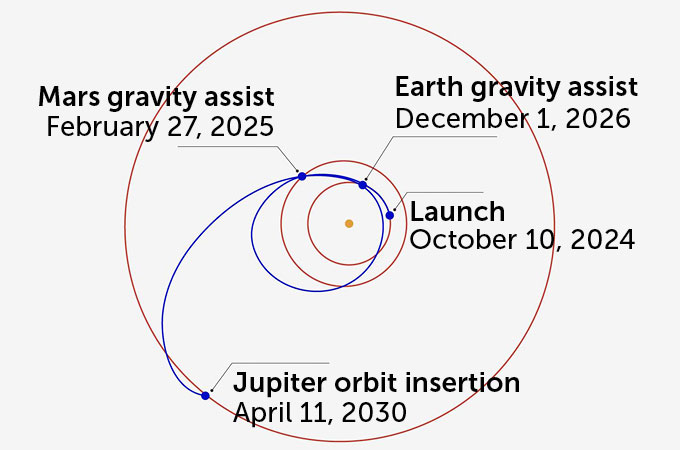NASA’s Europa Clipper spacecraft is on its way to help solve a quarter-century-old mystery: Could anything live in the ocean lurking beneath the icy shell of Jupiter’s moon Europa?
“This is a mission we’ve dreamed about for 25 years now, since I was in graduate school,” says planetary geologist Cynthia Phillips of NASA’s Jet Propulsion Laboratory in Pasadena, California. “It’s a generational mission.”
An Oct. 10 launch from the Kennedy Space Center in Florida was canceled because of Hurricane Milton, but on Oct. 14, the spacecraft lifted off just after noon ET and began its five-and-a-half-year journey to Jupiter.
Once there, Clipper will be placed into orbit around the giant planet in April 2030, repeatedly passing the icy moon to take pictures of its frozen terrain, measure the surface’s chemistry and deduce internal structure of the moon.
“We think ocean worlds may actually be a common type of world outside our solar system,” NASA’s planetary science chief Gina DiBraccio said at a Sept. 17 press conference. “Clipper will be the first in-depth mission that will allow us to characterize habitability on what may be the most common type of habitable world in our universe.”
Planetary scientists have become increasingly confident that Europa hosts a subsurface ocean since NASA’s Galileo spacecraft visited Jupiter in the 1990s.SN: 18.2.02).
“During the Galileo mission, it was like a detective story,” says Phillips. Constructed data. The lack of craters suggests that the surface is always moving and changing. Lines, cracks and pits, suggesting uplift from below. Regions known as “chaos terrain”, which look like tipped icebergs in a sloping sea (SN: 11/16/11).
And finally, the measurement of an internal magnetic field caused by Jupiter’s external one. This was the “coup d’état,” says Phillips. The only geologically plausible material that can sustain this magnetic field is salt water.
On Earth, water means life. But the findings in Europa were not enough to declare it a habitable world (SN: 19.4.24). Many mysteries remained: How deep is the ocean? How thick is the ice shell? And more importantly, how do they interact? Could material from the surface sink into the salty depths to provide food for the microbes that wait?
The Europa Clipper, named for the fast clipper ships of the 19th century, is poised to pick up where Galileo left off. The spacecraft is tasked with investigating the habitability of Europa by searching for three main ingredients: water, energy and organic compounds.
The spacecraft will not directly orbit Europa. The moon is located within Jupiter’s punishing radiation environment, where high-energy charged particles accelerated by the planet’s magnetic field can fry spacecraft components (SN: 11/9/20). Instead, Clipper will dip in and out of that radiation zone to fly past Europa at least 49 times — aiming all nine of its instruments at the Moon at once — each time retreating to quieter territory to process the data and send it back to Earth. .

One of the first things Clipper will do when it arrives is confirm — or perhaps disprove — the presence of the subsurface ocean. How the moon gravitationally pulls the spacecraft will immediately reveal the details of its interior, JPL’s deputy project scientist Bonnie Buratti said at the press conference.
The pictures will come next. Galileo’s antenna was never positioned properly, so its images weren’t as sharp as they could have been, Phillips says. Galileo’s spectrometer wasn’t designed to work on Europa either, so scientists tried to find out the composition of anything that wasn’t ice on the surface. Clipper’s images and spectra will reveal clues about surface and possibly subsurface chemistry that Galileo never could.
Finally, Clipper will delve into details like the thickness of the crust, the depth of the ocean, and how they interact.
There are some limitations. Clipper’s gaze will not reach the bottom of the ocean, where rock and water meet. This may be the most likely place for microbial ecosystems to take shelter, similar to seafloor vents on Earth. But Clipper won’t be able to sense them directly.
However, there is strong circumstantial evidence that water sometimes rises to the surface, either in plumes of steam or in slower-flowing streams or lakes, and may deposit any other material it carries in the ice.SN: 14.5.18). Clipper will search for chemicals on the surface and find out what might be brewing in the dark depths.
“The holy grail would be if we could see something like an amino acid on the surface,” says Buratti. “But only by looking at many organic molecules will there be good evidence that we have all the conditions for life.”
What Clipper won’t do is search directly for life. “We don’t have a tricorder that we can point from Europa and say, ‘It’s life, Jim!'” like in Star Trek, Phillips says. “It will again be multiple lines of indirect evidence.”
“To do a life detection mission,” she says, “you’re going to have to touch that surface.” Or maybe it falls under it (SN: 5/2/14).
As long as he’s had to wait to get to Europe, Phillips doesn’t expect to see that mission for himself. But she hopes scientists won’t have to wait another 25 years.
“I hope this momentum will grow,” she says. “I accept that I probably won’t see that Europa submarine, but I hope my children or maybe my grandchildren will.”
#Europa #Clipper #set #solve #alien #mystery
Image Source : www.sciencenews.org